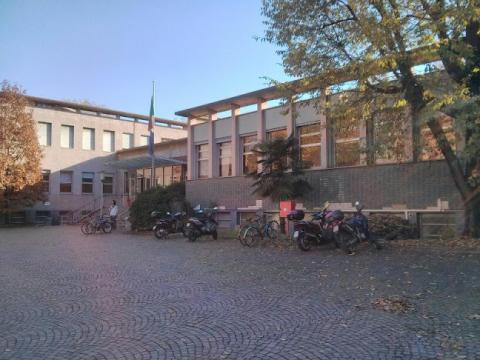National Institute for Nuclear Physics (INFN) and Physics Department Milano
Institute

INFN-Sezione di Milano and Physics Department, Universita' degli Studi di Milano
Via Celoria, 16
20133 Milano (MI)
Italy
+39 (02) 50317651
Francesco Tartarelli
Leonardo Carminati
The Istituto Nazionale di Fisica Nucleare (INFN) and the Physics Department of the "Universita' degli Studi di Milano" jointly carry out researches in various scientific fields: fundamental interactions with accelerators, fundamental interactions without accelerators, nuclear physics, theoretical physics and technological research. These activities are developed in international collaboration and scientific networks with Institutes from all over the world.

INFN-Sezione di Milano and Physics Department, Universita' degli Studi di Milano
Via Celoria, 16
20133 Milano (MI)
Italy
+39 (02) 50317651
Francesco Tartarelli
Leonardo Carminati
The Istituto Nazionale di Fisica Nucleare (INFN) and the Physics Department of the "Universita' degli Studi di Milano" jointly carry out researches in various scientific fields: fundamental interactions with accelerators, fundamental interactions without accelerators, nuclear physics, theoretical physics and technological research. These activities are developed in international collaboration and scientific networks with Institutes from all over the world.
The Milano unit is one of the founding units of INFN and seeks answers to fundamental questions in particle physics using a wide spectrum of methods ranging from particle accelerators, nuclear physics to theoretical phenomenology. The Institute also includes the LASA (Accelerators and Applied Superconductivity Laboratory), located in Segrate, a few km from the town of Milano. LASA has well-established expertise in particle acceleration techniques using radiofrequency or lasers, design of superconducting magnets and resonant cavities, criogeny and vacuum technology.
The particle physics program includes experiments at the LHC collider at CERN (ATLAS, LHCb) and astroparticle experiments: Borexino at the LNGS laboratory, AUGER, ICARUS. Nuclear physics experiments include AEGIS at CERN, LUNA3 at the LNGS and GAMMA. The Institute is also active in GRID/distributed computing and its Computing Center hosts one of the four Italian Tier2's of the ATLAS experiment.
L'Universita' degli Studi di Milano is the largest of the universities in Milano and one of the largest in Italy. The Physics Department also performs research activities in Astrophysics, Electronics, Environmental Phyiscs, Condensed Matter Phyiscs, Nuclear Phyiscs, Medical Physics, Nanotechnologies and Theoretical physics. These are performed in cooperation with the National Institute for Astrophyiscs (INAF), the National Interuniversity Consortium for the Physical Sciences of Matter (CNISM), the National Research Council (CNR). It also hosts the Interdisciplinary Centre for Nanostructured Materials and Interfaces (CIMaINa).
The educational program includes Bachelor and Master in Physics Degree Programmes, a Physics, Astrophysics and Applied Physics PhD School and a Specialization School in Medical Physics.
La Sezione di Milano dell'INFN e' una delle sezioni fondatrici dell'INFN e cerca risposte a domande fondamentali in fisica delle particelle elementari utilizzando un largo spettro di metodi che vanno dagli acceleratori di particelle, alla fisica nucleare e alla fenomenologia teorica. L'Istituto include anche il LASA (Accelerators and Applied Superconductivity Laboratory), sito a Segrate, a pochi km di distanza da Milano. Il LASA ha una ben riconosciuta esperienza in tecniche di accelerazione di particelle utilizzando radiofrequenze o laser, nella progettazione di magneti superconduttori e cavita' risonanti, in tecniche criogeniche e tecnolgia del vuoto.
Il programma di fisica delle particelle elementari include esperimenti al CERN (ATLAS, LHCb) e esperimenti di fisica astroparticellare: Borexino ai Laboratori Nazionali del Gran Sasso (LNGS), AUGER, ICARUS. Gli esperimenti di fisica nucleare includono AEGIS al CERN, LUNA3 ai LNGS e GAMMA. L'Istituto e' anche attivo nel calcolo distribuito/GRID e il suo Centro Calcolo ospita uno dei quattro Tier2 italiano dell'esperimento ATLAS.
L'Universita' degli Studi di Milano e' la piu' grande delle Universita' di Milano e una della piu' grandi d'Italia. Il Dipartimento di Fisica porta avanti attivita' di ricerca anche in Astrofisica, Elettronica, Fisica Ambientale, Fisica dello Materia Condensata, Fisica Nucleare, Fisica Medica, Nanotecnologie e Fisica Teorica. Queste attivita' sono condotte in collaborazione con l'Istituto Nazionale di Astrofisca (INAF), il Consorzio Nazionale Interuniversitario per le Scienze Fisiche della Materia (CNISM) e il Consiglio Nazionale delle Ricerche (CNR). E’ anche attivo il Centro Interdisciplinare Materiali e Interfacce Nanostrutturati(CIMAINA).
Il programma didattico include i Corsi di Laurea Triennale e Magistrale in Fisica, la Scuola di Dottorato in Fisica, Astrofisica e Fisica Applicatae una Scuola di Specializzazione in Fisica Medica.

